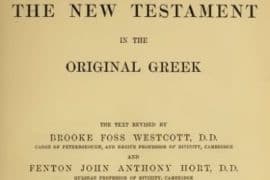Bart Ehrman has a very interesting post up on his blog (July 3) titled “Do Matthew and Paul Agree on the Matter Most Important to them Both?” I highly recommend both the post and the blog. [1]The blog requires a membership fee, which is rare among us Bible Bloggers, but I think a brilliant idea in Bart’s case. 100% of the minimal annual membership fee ($25) is donated to “feed … Continue reading At issue is the matter of whether one obtains “eternal life” by “keeping the commandments” (as per Matthew 19:16-22) or by grace through faith in the atoning sacrifice of the blood of Christ (as per Paul in Romans 3:19-26). Most of us who teach New Testament are keen to encourage our students (and our blog readers!) to do constructively critical analyses of the various ways of understanding “salvation” or the “ways of being religious” as reflected in the diverse perspectives within our N.T. documents. It is easy to attempt to “harmonize” just about anything with enough imaginative creativity, but to see comparative differences seems for some students of the Bible to offer more of a challenge. After all, like many of my readers, I grew up thinking that the Bible speaks with a single voice–and if it seems otherwise the problem is with the reader who is somehow “misunderstanding” the texts under consideration.
Reading Bart’s post this morning caused me to think about a very intriguing “textual variant” in the Greek text of the book of Revelation. It is of particular note since I guess one could identify it as the last recorded words of Jesus. That ought to count for something. I am thinking here of Revelation 22:12-16. [2]The RSV and other modern translations have v. 12 and v. 16 in quotations marks, as spoken by Jesus, but leave out the quotations marks for vv. 14-15. I see no reason for this break in syntax. It … Continue reading Notice the two contrasting textual traditions of Rev. 22:14, first in the King James Version, followed by the Revised Standard Version:
“Blessed are those that do his commandments, that they may have right to the tree of life, and may enter in through the gates into the city” (KJV).
“Blessed are those who wash their robes, that they might have the right to the tree of life and that they may enter the city by the gates.” (RSV).
Here, clearly, “wash their robes” hearkens back to Revelation 7:14 where the robes of the righteous are made white by washing them in the “blood of the Lamb,” surely a bizarre image on the face of things. Its strangeness has, of course, been made familiar within our evangelical Christian culture over the past one-hundred and fifty years, particularly through emotional hymns such as “Are You Washed in the Blood of the Lamb?” or another I remember, “There’s Power in the Blood.” I can still hear those words sung with enthusiasm and conviction, echoing through the church buildings I grew up in, as sinners were exhorted to “come forward” and be saved. [3]“Are You Washed in the Blood” was written by A. E. Hoffmann, was published in 1878 and by one count appears in 371 hymns, … Continue reading

This image of washing of garments in blood is in stark contrast to Isaiah’s image of washing away sins through repentance and righteous actions: “Come now, let us reason together, says YHVH: though your sins are like scarlet, they shall be as white as snow; though they are red like crimson, they shall become like wool”( Isaiah 1:18). Indeed, for Isaiah, garments stained with blood are a symbol of vengeance and bloody destruction, not salvation (Isaiah 63:1-6). Many stirring passages in the Hebrew Bible emphasize the free offer of grace and forgiveness, as a father for a son, with no need of “sacrifice,” whether animal or human (Micah 6:7-8; 7:18-20; Psalm 103:11-14). I can’t count the times I have had students remark, as we work through such passages, “But does not the Old Testament say that without the shedding of blood, there is no remission of sins?–which comes from the New Testament book of Hebrews, not the Hebrew Bible.
But back to this rather fascinating variant in the “last words of Jesus” that one would think we should at least try to get right. The difference between “doing the commandments” vs. “being washed in the blood,” as the way to obtain access to the tree of life–precisely the contrast that Bart Ehrman was attempting to get folks to think through in his blog post.
The King James Version reflects the Byzantine Textus Receptus and most minuscules. It is usually dismissed as a later scribal emendation based on the desire to bring the verse into harmony with the phrases “keep the commandments” found in Rev. 12:17 and 14:12, as markers of those who are God’s redeemed people. The RSV, and most all modern versions, correct the text to read “wash their robes,” which is found in two of our oldest and most complete codices, Sinaiticus and Alexandrinus. However, once might well argue the opposite, namely, that the “wash their robes” reading is a scribal emendation to bring things into harmony with Rev. 7:14–those robes washed in blood. One can see how this would appeal theologically to copyists wishing to emphasize in Jesus’ final words his death for our sins.
I have argued elsewhere that the book of Revelation, in the heavily interpolated and redacted form we have, represents a Christian reworking of an underlying Jewish apocalypse that had originally nothing to do with Jesus. Rather, it was a Jewish apocalypse, recasting of the visions of the book of Daniel, much like 2 Esdras. For a summary of this view see my posts “Can A Pre-Christian Version of the Book of Revelation Be Recovered?” and “Here it is at Last: A Pre-Christian Version of the Book of Revelation!” The latter offers a hypothetical reconstruction of what such a text might have looked like.
However, the point of my post here, building off Bart Erhman’s post on Matthew and Paul, is that we seem to have reflected, even in just these two variant readings of Revelation 22:14, two very different ways of understanding salvation within the New Testament. This dichotomy is found throughout our New Testament documents.
Luke, for example, relates the story of the two men who pray in the Temple, only one of whom is “justified,” not by any atoning sacrifice of Christ, but through a humble cry of repentance (Luke 18:9-14). In fact, this story is followed immediatley by Luke’s version of the Mark/Matthew “keep the commandments” pericope (Mark 10:17-31; Matt 19:16-30). And then there is Luke’s extended story we have named “the Prodigal Son,” in which “justification” or being “right” with God, is comes through repentance and returning “to the Father.” Most readers have grappled with the stark differences between the letter of James, contrasted with Paul. James has no reference whatsoever the Jesus’ death, the cross, or atonement, yet he argues for “justification by faith,” as evidenced by keeping the same set of commandments quoted by Jesus (James 2:8-26). Many scholars have seen his exposition as a conscious refutation of Paul’s arguments in Romans 3-4. Both James and Paul use Abraham as their prime example of such “justification by faith,” but Abraham’s “faith” was in God and his promises, not in the blood sacrifice of Jesus. Even Paul’s quotation of Psalm 32:1-2 belies his point, since the very text he quotes is clearly about repentance and confession of sins, not blood atonement (Romans 4:1-8).
This really gets to the heart of how one understands the entire “Law and Grace” teachings of Paul, and his relationship to aspects of Judaism espoused by his opponents. I just finished reading Paula Fredriksen’s new book, When Christians Were Jews: The First Generation, which I highly recommend, though we differ on a number of key issues.
One dominant debate in the field of “Pauline studies” is whether Paul remained a Torah observant Jew, while maintaining that all humankind, whether Jew or Gentile, can only find salvation or “justification” by grace and faith in Jesus’ atoning death. For those who argue that Paul continued to observe the Torah, his statements regarding the impossibility of justification by “works of the Law” are taken as representing his strident objections to Gentiles who have been saved through Christ, thinking they needed to convert to Judaism in order to please God more fully. I have expressed my own views on this controversy in my book, Paul and Jesus: How the Apostle Transformed Christianity, in chapter 8 titled “The Torah of Christ.” Although I agree that Paul’s ideas on justification by faith were stripped of their Jewish contexts by Luther and the Reformers, I nonetheless hold that Paul as a Jew considered the Sinai covenant obsolete and abrogated, for Gentiles of course, but also for Jews. Joel Marcus encapsulates the issue well in his recent review of Fredriksen’s book:
The torah-observant Paul whom Fredriksen describes, moreover, seems different to me from the Paul who emerges from his own letters. It is true that the critical things he says about Moses, Mount Sinai, and the torah in Galatians, Romans, and 2 Cor 3–4 are addressed to gentiles, but none of Paul’s arguments apply only to gentiles. They are, rather, ontological and categorical, stressing the transitory nature of the Mosaic dispensation, the insufficiency of the torah to combat sin, and the intrinsic linkage between Sinai and bondage. While Paul says laudatory things about the giving of the torah and the temple liturgy in Rom 9:4, this is not necessarily indicative of his own degree of observance but an attempt to establish a point of contact with the “relatives according to the flesh” whom he is about to criticize for, among others things, seeking righteousness through the law. Further, any attempt to portray Paul as torah observant runs aground, in my opinion, on the shoals of 1 Cor 9:20–23, a passage that Fredriksen does not mention in this book and gives only cursory attention in The Pagan’s Apostle. Here Paul acknowledges that he sometimes observes the torah— but only when it is convenient, only when he is among Jews, in order to win some of them to Christ. When it is not convenient, when he is among the anomoi (“lawless” gentiles), he becomes like an anomos himself. [4]https://www.bookreviews.org/pdf/13256_14790.pdf
I hold the view that it is Paul who pretty much singlehandedly generated out of whole cloth the entire construct of Jesus as the atoning sacrifice for the sins of the world, now reflected in the Synoptics and John, as well as scattered throughout most of the New Testament. Paul is our earliest source for these ideas and his influence on all the rest is towering. This idea is so ubiquitously embedded in our sources and much of early Christian tradition, that an alternative understanding of Jesus as the rejected Prophet and Righteous martyr, with the call to courageously “take up a cross” and follow, has been subsumed with the John 3:16 mantra that “Jesus paid it all.” Nonetheless, one can find alternative views of “salvation” that do not involve Jesus as the atoning sacrifice for the world’s sins.
Luke, particularly, emphasizes this role of Jesus as a “Prophet mighty in deed and word” who would bring about the messianic Kingdom of God (Luke 18:29-30; 22:28-30; 24:19; Acts 17:31 ). [5]Luke says nothing about the atoning sacrifice of Jesus’ blood beyond the interpolation of Luke 22:20, see my post, “Older is Not Necessarily Better,” and the confused textual … Continue reading Other bits and pieces of this alternative view surface here and there throughout Luke-Acts, especially in the Q materials, (Acts 7:51-53; Luke 9:23-27; 11:49-51; 13:34-35), [6]See Restoring the Lost Gospel Scholars Call Q. in the letter of James (5:1-6), and here and there in Ebionite and other eastern Christian traditions. Theophilus, the second century bishop of Antioch, is a prime example, see my article “The Theology of Redemption in Theophilus of Antioch. In the end, however, it was Paul’s view that found the most favor and prevailed.









Comments are closed.